From Scandals to Snooker: The Brian Boru Club, Ashton-in-Makerfield
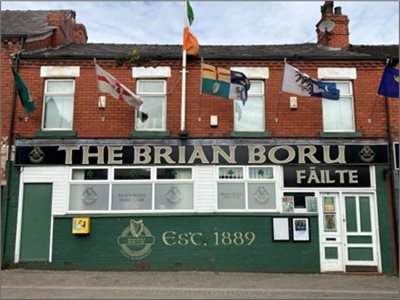
Front elevation of the Brian Boru Club on Bryn Street. Source: Author’s own photograph.
Ever since commencing work on the Town Centre Building Grant Scheme in Ashton-in-Makerfield, I have wanted to understand the Irish origins and connections in the town. The Brian Boru Club therefore came straight to mind, especially with it being the oldest Irish Club in Great Britain!
Through this blog post I will explore the Club’s background history, understand exactly who Brian Boru was, discuss the club’s historically active role in snooker tournaments and some historical scandals.
Background – Historic Development
The Brian Boru Club has always been a key community focused building in Ashton with its core premise ‘to promote Irish history, culture, music and dance’. It was founded in 1889 by a group of Irish emigrants who left Ireland to find work in the industrial cities of Northern England.
However, we know the Club’s community ‘goes all the way back to 1886’. A meeting was held on 1st May 1887 regarding new members of the Brian Boru Club. The Weekly Freeman’s Journal states the meeting was held at the Queen’s Head Inn and that ‘sixteen new members were enrolled’.
The Queen’s Head Inn no longer exists, but was located on Liverpool Road opposite St Oswald’s Roman Catholic Church, which is now a small park. A conversation amongst locals on Wigan World recalled that it was also known as the ‘Top Head’ and the historic image below was uploaded.
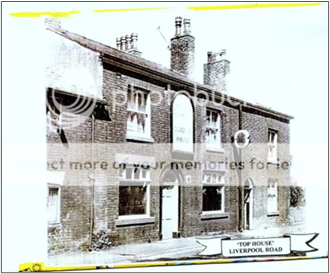 Queen’s Head, also known as the ‘Top House’. This image was uploaded by Frank Walford on 18th February 2015.
Queen’s Head, also known as the ‘Top House’. This image was uploaded by Frank Walford on 18th February 2015.
Source: Wigan World.
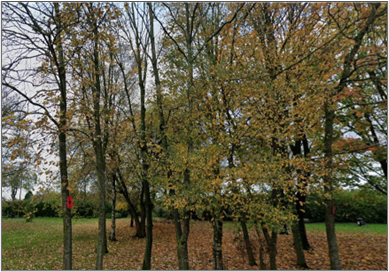 Area of parkland opposite St Oswald’s Church where the Queen’s Head was previously situated.
Area of parkland opposite St Oswald’s Church where the Queen’s Head was previously situated.
Source: Google Streetview.
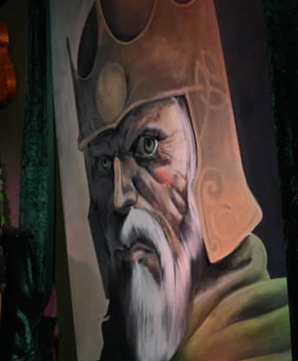 Artwork of Brian Boru, the last High King of Ireland, in the Brian Boru Club.
Artwork of Brian Boru, the last High King of Ireland, in the Brian Boru Club.
Source: Wigan Today.
But where did the Club get its name from?
‘Brian Boru’ is an iconic figure in Irish history who was the last High King of Ireland from 1002 to 1014. He was active during the Viking period as his primary aim was to rebuild the plundered churches and reorganise the church in Ireland.
The famous Battle of Clontarf, which was fought on Good Friday in 1014 between Brian’s forces and the rebels of Dublin who were supported by Vikings from Orkney, met a bloody end. A group of retreating Vikings murdered Brian who was praying in his tent, thus making him the final High King of Ireland. However, Brian’s fame was so great that the princes, the O’Briens, descended from him.
Brian’s bravery and widespread fame throughout Ireland suggests why the founders named the Club after him.
The start of the Irish roots in the town came in the mid to late seventeenth century when the first coal mines and cotton mills were built around Ashton. However, it was the coal mining industry that particularly thrived in Ashton and ‘played a vital role in the life of the community’.
The expanding mining and cotton industries meant increased job opportunities, and many immigrants came from Ireland and Wales to work, and this was the case with the founders of the Brian Boru Club. This led to a rapid population growth in the latter part of the nineteenth century from 5,679 people in 1851 to 18,687 in 1901.
Today, the Brian Boru Club is located on Bryn Street. When analysing the 1891 Ordnance Survey Map, Bryn Street had not yet been developed. However, by 1908 extensive development has occurred, which correlates with the population growth. The building now occupied by the Brian Boru Club was therefore erected during this seventeen year period.
As previously mentioned, the Club itself was founded in 1889 suggesting they either relocated to Bryn Street from a previous location or waited for the club to have an adequate number of members before taking on a building. Either way, it is highly likely that the Brian Boru Club has occupied 55 Bryn Street since it was constructed.
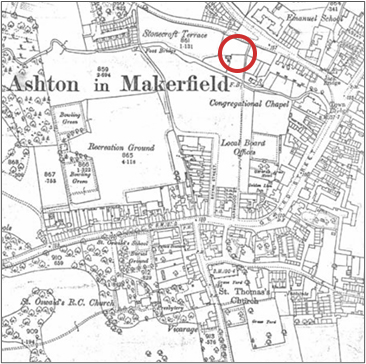 1891 Ordnance Survey Map. The red circle highlights the approximate location of the Brian Boru Club. Note there had been no development on Bryn Street, and Garswood Street was yet to be established.
1891 Ordnance Survey Map. The red circle highlights the approximate location of the Brian Boru Club. Note there had been no development on Bryn Street, and Garswood Street was yet to be established.
Source: Wigan Council.
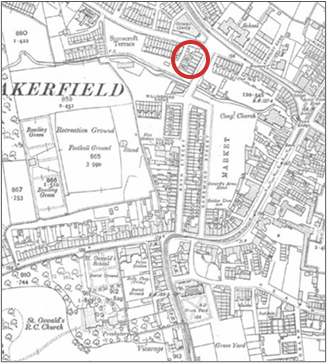 1908 Ordnance Survey Map. The red circle highlights the approximate location of the Brian Boru Club. Note 55 Bryn Street had been constructed by 1908, and further development had occurred throughout the town.
1908 Ordnance Survey Map. The red circle highlights the approximate location of the Brian Boru Club. Note 55 Bryn Street had been constructed by 1908, and further development had occurred throughout the town.
Source: Wigan Council.
Although I don’t know for certain when the Club moved to Bryn Street, it was definitely there in 1924. Kelly’s Directory of 1924 states that ‘Thos. Dooney’ was the steward and lists the Club as being at 55 Bryn Street.
In David Fearnley’s series of articles A Nostalgic Walk Around Ashton-in-Makerfield, he recalls how Bryn Street used to look and some of the key shops and buildings located there. Although he does not explicitly mention the Brian Boru Club, he states that ‘Beverley’s clothes shop was on the corner with Old Road’, which would have been next door to the Club. Perhaps Mr Fearnley was yet to enjoy (and thus missed out on) an Irish inspired evening at the Club, so did not include it.
Today, the Brian Boru Club hosts a variety of fun events for all ages, which are centred around celebrating Ireland’s heritage. Community is at the heart of the Club and there is always something on offer for everyone. Its claim to fame is that it is now the oldest Irish Club in Great Britain!
Scandals – intoxication to fire!
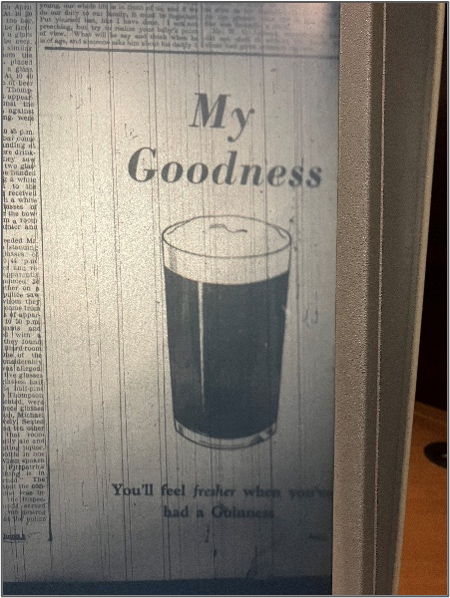 Advert for Guiness directly next to the ‘Police Raid Ashton Club’ article.
Advert for Guiness directly next to the ‘Police Raid Ashton Club’ article.
Source: Wigan Observer.
Like every good public house, the Brian Boru Club has had its fair share of scandalous activities.
When I was researching at the Wigan Archives, I came across an article in the Wigan Observer titled ‘Police Raid Ashton Club’. This was regarding the Brian Boru Club which was raided by police in 1937 due to illegal drinking allegations which reportedly took place throughout April.
The article states that ‘stewards were alleged to have supplied intoxicating liquor during non-permitted hours, members were summoned for consuming, and officials were alleged to have aided and abetted in the supply and consumption’. This was taken very seriously as there was an application for the Club to be struck off and a request that the penalties be fairly substantial.
A gentlemen named Mr Gibbons asked ‘was there any froth on the drink’ to which Mr Platt replied ‘oh yes sir’! Ironically, there was an advert for Guiness directly next to this article about illegal drinking allegations. This had to be done on purpose, right?!
The article mentions that the Club Steward at the time was James Fitzpatrick who was married to Alice Fitzpatrick. I conducted an Ancestry search and found a James and Alice Fitzpatrick on the 1921 Census.
According to the Census, James was a ‘coal hewers drawer miner’ who worked for the Garswood Hall Colliery Co Ltd, and we know that many of the Brian Boru Club members were coal miners.
It also stated they lived in Ashton at 132 Bolton Road. Looking on Google Streetview, it appears 132 Bolton Road, and associated terraced houses, has been demolished and replaced with an Esso Garage and Tesco Express!
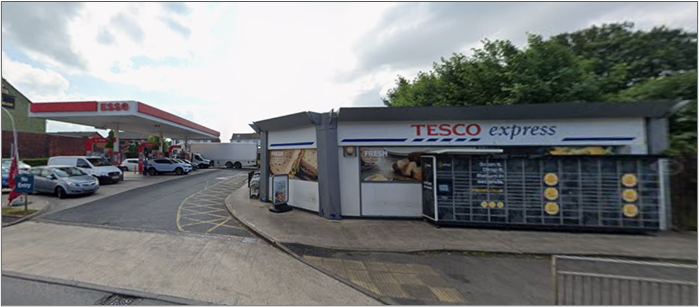 Tesco Express on Bolton Road. Previously there was terraced housing on this site including 132 Bolton Road.
Tesco Express on Bolton Road. Previously there was terraced housing on this site including 132 Bolton Road.
Source: Google Streetview.
Following a few peaceful decades, in 1963 the Newton and Earlestown Guardian reports of a ‘Fire at Brian Boru Club’. The article states the fireman ‘rushed into the Brian Boru Club… expecting to find a blazing fire’, but they only found the last members leaving the Club meaning the call was ‘malicious’.
It was also stated that the fire brigade had numerous malicious calls during June-July of 1963. I wonder if someone drinking at the Club was responsible or was it just a prank gone wrong?
Snooker Champs
Despite the scandals, the Brian Boru Club was arguably best known for its many successes with sports, particularly snooker tournaments. The first reference I could find to sporting events was in August 1923, but it didn’t start with snooker!
In 1923 the Newton and Earlestown Guardian reported that the Brian Boru Club won the tug-of-war contest which was held at Sutton Recreation Ground. It was described as being an ‘exciting contest’ where the Club defeated much more experienced teams including ‘Merseyside’ and ‘Wilson’s’ of Manchester. The tug-of-war victory was just the start of many more in the future.
In 1958 the Brian Boru made the headline of the Newton and Earlestown Guardian which stated they ‘swept the board’. The Club secured two victories against the Vulcan Social Club and Golborne Catholic Club and were the ones to beat throughout the snooker league. They became the ‘favourites’ to win, with the 1958 Newton and Earlestown Guardian describing them as the ‘all-star Ashton Brian Boru’.
Their winning streak continued into 1959 when they secured the victory against Earlestown.
Although they didn’t win every game, the Newton and Earlestown Guardian described them as being ‘narrowly beaten’ (1957) or ‘beaten in the final’ (1959), suggesting the Club always put up a good fight!
The Brian Boru Club Today
As previously mentioned, the Club is very active in the local community and hosts daily classes and events focused on Irish dance, music, history and culture. The safe and friendly atmosphere of the Club today has stemmed from when the Club was formed in 1889.
In addition to this, the Club has also engaged with the wider community by undertaking an Ancestry project, helping people to research and build their family trees.
The Club’s Community and Culture Development Officer, Maxine Williams, spearheaded this project and they have already worked with 37 people. The group meets every Monday morning to afternoon and Wednesday evenings. What an incredible project which has enabled individuals in the local community to find out more about their ancestors by using sources, such as Ancestry, which many don’t have access to.
Conclusion
The Brian Boru Club has been long established in Ashton-in-Makerfield, being the oldest Irish Club in Great Britain, and has always been a community centred building. The Club has an interesting history with historic associations with Brian Boru, being accused of some scandalous activities and securing numerous snooker victories.
Today, the Club is just as community focused, offering a wide range of classes and events for all ages and undertaking an Ancestry project. What a place to have in the centre of Ashton!
This blog post has been researched and written by Anna Standring of Creative Heritage Consultants Ltd, as part of the Ashton-in-Makerfield Town Centre Building Grant Scheme which is funded by HM Government. As part of the Building Grant Scheme a gutter cleaning project was organised, and the Brian Boru Club was one of the twelve properties who had this work completed.
We would also love to hear any more stories and memories about the Brian Boru Club and other properties in Ashton. We will be publishing blog posts at the end of each month so please complete a form submission on the blog homepage with any memories or interesting information we could include.
Bibliography
Ancestry. (2025) ‘Ashton-in-Makerfield’, 1924 Kelly’s Directory. Available at: https://www.ancestry.co.uk (Accessed 17 March 2025)
Ancestry. (2025) ‘James Fitzpatrick’, 1921 England Census. Available at: https://www.ancestry.co.uk/search/collections/63150/records/2737133 (Accessed 17 March 2025)
Brian Boru Club. (2021) ‘History’, About Us. Available at: https://brianboruclub.com/about/ (Accessed 17 March 2025)
Britannica. (2025) ‘Brian King of Ireland’, History and Society. Available at: https://www.britannica.com/biography/Brian (Accessed 17 March 2025)
Discovering Ireland Vacations. (2025) ‘Brian Boru’, History of Ireland. Available at: https://www.discoveringireland.com/brian-boru/ (Accessed 17 March 2025)
Fearnley, D.A. (no date) A Nostalgic Walk Around Ashton-in-Makerfield.
Google. (2025) Google Streetview. Available at: https://www.google.com/maps (Accessed 18 March 2025)
Irish in Britain. (2025) ‘Irish Democratic League Brian Boru Branch’, Who We Are. Available at: https://www.irishinbritain.org/who-we-are/our-members/irish-democratic-league-brian-boru-branch (Accessed 17 March 2025)
The British Newspaper Archive. (2025) ‘Ashton-in-Makerfield (Brian Boru)’, Weekly Freeman’s Journal – Saturday 07 May 1887. Available at: https://www.britishnewspaperarchive.co.uk/viewer/bl/0001446/18870507/040/0003 (Accessed 17 March 2025)
The British Newspaper Archive. (2025) ‘Black night for Newton Teams, Brian Boru go merrily along’, Newton and Earlestown Guardian – Friday 03 April 1959. Available at: https://www.britishnewspaperarchive.co.uk/viewer/bl/0005262/19590403/333/0004 (Accessed 17 March 2025)
The British Newspaper Archive. (2025) ‘Brian Boru beaten in the final’, Newton and Earlestown Guardian – Friday 06 March 1959. Available at: https://www.britishnewspaperarchive.co.uk/viewer/bl/0005262/19590306/119/0005 (Accessed 17 March 2025)
The British Newspaper Archive. (2025) ‘Brian Boru Club’, Newton and Earlestown Guardian – Friday 24 August 1923. Available at: https://www.britishnewspaperarchive.co.uk/viewer/bl/0005262/19230824/070/0005 (Accessed 17 March 2025)
The British Newspaper Archive. (2025) ‘Brian Boru Have Swept The Board’, Newton and Earlestown Guardian – Friday 25 April 1958. Available at: https://www.britishnewspaperarchive.co.uk/viewer/bl/0005262/19230824/070/0005 (Accessed 17 March 2025)
The British Newspaper Archive. (2025) ‘Brian Boru stars are favourites’, Newton and Earlestown Guardian – Friday 11 April 1958. Available at: https://www.britishnewspaperarchive.co.uk/viewer/bl/0005262/19580411/032/0002 (Accessed 17 March 2025)
The British Newspaper Archive. (2025) ‘Defeated the Leaders’, Newton and Earlestown Guardian – Friday 15 February 1957. Available at: https://www.britishnewspaperarchive.co.uk/viewer/bl/0005262/19570215/307/0007 (Accessed 17 March 2025)
The British Newspaper Archive. (2025) ‘’Fire at Brian Boru Club’ call was malicious’, Newtown and Earlestown Guardian – Friday 05 July 1963. Available at: https://www.britishnewspaperarchive.co.uk/viewer/bl/0005262/19630705/016/0001 (Accessed 17 March 2025)
Weston, A. (2024) ‘Irish Club’s groundbreaking Ancestry project traces the amazing stories of Wigan families’, Wigan Today. Available at: https://www.wigantoday.net/heritage-and-retro/heritage/irish-clubs-groundbreaking-ancestry-project-traces-the-amazing-stories-of-wigan-families-4677588 (Accessed 17 March 2025)
Weston, A. (2023) ‘You don’t have to be Irish to enjoy the craic at Wigan’s Brian Boru Club’, Wigan Today. Available at: https://www.wigantoday.net/heritage-and-retro/heritage/you-dont-have-to-be-irish-to-enjoy-the-craic-at-wigans-brian-boru-club-4061947 (Accessed 17 March 2025)
Wigan Council. (no date) Historic Development. Available at: https://www.wigan.gov.uk/Docs/PDF/Resident/Planning-and-Building-Control/AshtonHistoricDevelopment881kb.pdf (Accessed 17 March 2025)
Wigan Observer. (1937) ‘Raided by police. Illegal drinking allegations. Details of court proceedings’, Wigan Archives WO. 12.6.1937 p13f,e.
Wigan World. (2025) ‘The Old Millstone Pub off Heath Road A In M’, Communicate. Available at: https://www.wiganworld.co.uk/communicate/mb_message.php?opt=f2&opt2=&msd=1181992&offset=40&subject=The%20Old%20Millstone%20Pub%20off%20Heath%20Road%20A%20In%20M (Accessed 18 March 2025)
Posted on Thursday 19th June 2025